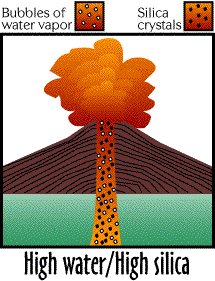



|
 Types of Lava Types of Lava
Different types of lavas show behaviors that are similar to
our analogies of blowing bubbles in water or a milk shake. If an erupting lava has low
viscosity ( like water) and little or no dissolved gases, it simply flows out of the
central vent and spreads far and wide over the surface (see low
water/low silica figure). If it has high viscosity (like a milk shake) and no
dissolved gases, the lava oozes slowly out to form a bulbous dome which hardly moves at
all (see low water/high silica figure). In either case, you
could stand nearby in relative safety. If the erupting lava has lots of dissolved gases,
the gases come out of solution and form bubbles as the lava approaches the surface. If the
viscosity of the lava is low, the lava bubbles and froths a great deal right at the
surface, tossing out tiny cinders and larger "bombs" of lava that quickly cool
and fall back to the ground. This type of eruption (see high water/low silica figure)
produces a spectacular "fire fountain" directly over the vent, usually resulting
in a cinder cone. Any remaining lava quietly flows away. |
 However, the last
combination, lots of dissolved gases and high viscosity, is deadly (see high water/high
silica figure). As the lava oozes to the surface, the gases quickly form bubbles that turn
the lava into a red-hot froth that explodes out of the ground as a searing, grayish cloud
of superheated steam and tiny particles called ash. The ash forms when the walls of the
gas bubbles burst into tiny fragments. This type of lava causes explosive eruptions at
volcanoes like Vesuvius and Mount St. Helens. However, the last
combination, lots of dissolved gases and high viscosity, is deadly (see high water/high
silica figure). As the lava oozes to the surface, the gases quickly form bubbles that turn
the lava into a red-hot froth that explodes out of the ground as a searing, grayish cloud
of superheated steam and tiny particles called ash. The ash forms when the walls of the
gas bubbles burst into tiny fragments. This type of lava causes explosive eruptions at
volcanoes like Vesuvius and Mount St. Helens. |
[ Types of Volcanoes ] [ Types of Lava: page 1 / page 2 / page 3 ]
[ Sizes of Eruptions ] [ Volcano
Eruption Animations ]
[
References ] [
PBL Model ]
[ Home
] [ Teacher
Pages ] [
Modules &
Activities ] |



